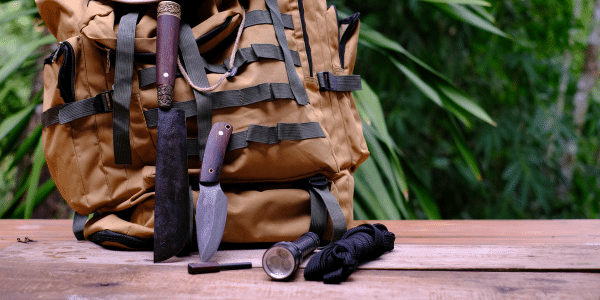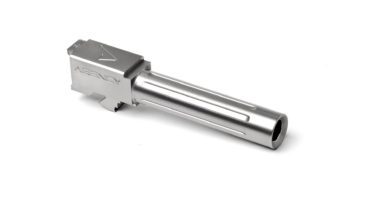From Chaos to Calm: An Essential Get Home Bag Guide
In a world where the unexpected is the only constant, there’s a single item that holds the power to transform chaos into calm, uncertainty into assurance, and vulnerability into resilience. What is the item? A get home bag.
Imagine a compact repository of survival, a portable sanctuary designed to weather the storm when life takes an unexpected turn. It’s more than just a bag — it’s a lifeline, a beacon of preparedness that silently waits for its moment to shine.
Welcome to the world of the get home bag — a meticulously crafted arsenal of essentials that stands as your steadfast ally in the face of emergencies, crises, and the unpredictable unknown.
Related Article: How to Get Prepared and Be Safe as an Urban Survivalist

As we dive deeper into this topic, we’ll uncover the art of assembling the perfect get home bag that will not only equip you with life-saving tools but will also empower you with the unwavering confidence to navigate whatever challenges lie ahead.
Table of contents
What is a Get Home Bag?
A get home bag is an emergency kit containing supplies to help you get home safely during an unexpected crisis or disaster.
The idea is to have a lightweight, portable bag that contains the essential supplies you might need if you ever have to abandon your vehicle or typical route home and travel by foot. The get home bag provides crucial items to aid survival, navigation, first aid, hydration, and communication in an emergency situation.
What is a Get Home Bag Used For?
A get home bag provides you with essential supplies and tools in the event of unexpected situations or emergencies that make it difficult to return to your home as you usually would.
The primary purpose of a get home bag is to help you safely navigate your way back to your home base when faced with disruptions to transportation, infrastructure, or other challenges. Here are some scenarios in which a get home bag can be incredibly useful:
1. Natural Disasters
In the aftermath of earthquakes, hurricanes, floods, or other natural disasters, roads and transportation systems might be severely impacted. A get home bag can help you navigate debris and obstacles to make your way back home.
2. Power Outages
Widespread power outages can disrupt public transportation, traffic lights, and communication systems. Having a get home bag with basic navigation tools, a flashlight, and communication devices can be invaluable in such situations.
3. Civil Unrest or Public Events
During instances of civil unrest, protests, or large public gatherings, transportation routes might be blocked or chaotic. A get home bag can help you safely navigate away from potential danger and back to the security of your home. Having essential gray man gear can help you get home safely.
4. Workplace or School Emergencies
If an emergency occurs while you’re at work or school, a get home bag can provide you with the necessary supplies to make your way back home if traditional transportation options are unavailable.
5. Traffic Jams or Road Closures
Unexpected traffic jams or road closures due to accidents or construction can leave you stranded far from home. A get home bag can equip you to navigate alternative routes on foot if needed.
6. Sudden Medical Situations
If you or someone you’re with experiences a medical emergency while away from home, having a get home bag with essential first aid supplies and medications can be crucial.
7. Public Transportation Failures
Public transportation systems might experience breakdowns or disruptions due to technical issues or accidents. A get home bag can help you manage the situation and find your way home without relying solely on public transportation.
8. Vehicle Breakdowns
If your vehicle breaks down or runs out of fuel, a get home bag can provide you with the necessary supplies to stay safe and make your way home on foot.
Related Article: Ferro Rods in Survival Kits — Why Every Prepper Should Have One
Remember, the contents of a get home bag should be tailored to your specific needs and the potential challenges you might face in your local environment. It’s a proactive approach to emergency preparedness that can give you peace of mind, knowing you have the necessary resources to handle unexpected situations and safely return to the comfort and security of your home.
How Big of a Bag Do You Need?
The size of a get home bag can vary based on individual preferences, the potential challenges you might face, and the distance you would need to travel to reach your home in an emergency. While there’s no one-size-fits-all answer, here are some factors to consider when determining the size of your get home bag:
- Distance
The farther away from home you typically are during your daily activities, the more supplies you might need in your get home bag. If you have a long commute or spend a lot of time away from home, you’ll likely need a larger get home bag to accommodate additional resources.
- Climate and Weather
The climate of your region will influence the type of clothing and gear you need. If you’re in an area with cold winters, you’ll need extra space for warm clothing and accessories.
- Personal Needs
Consider any specific medical conditions, dietary restrictions, or other personal needs that might require additional items in your get home bag.

- Skill Level
Your level of outdoor survival skills might affect the contents of your get home bag. Someone with more experience might opt for fewer items, while someone less experienced might prefer a more comprehensive kit.
- Duration
Think about how long it might realistically take for you to make your way home. Your get home bag should contain enough supplies to sustain you for that duration.
- Terrain
If your route home involves rough terrain or obstacles, you might need extra tools or equipment to navigate safely.
- Family Members
If you have family members with you, you’ll also need to consider their needs.

In terms of the bag’s physical size, it’s important to strike a balance between having enough space for necessary items and ensuring the get home bag is still manageable to carry. A backpack or messenger bag is a common choice, as it allows you to distribute the weight evenly and leaves your hands free for navigation.
Related Article: The Best EDC Knives on Amazon (Top 10 Edition)
Ultimately, your get home bag should contain the essential items needed to address potential challenges and emergencies while considering your personal circumstances. Regularly reviewing and updating your bag’s contents is vital to make sure it aligns with your current needs and any changes in your daily routine.
If you’re looking for a solid 3-day bag that you can pack out, I reviewed the Kelty Redwing and absolutely love this bag. Feel free to check out the review.
What Should You Have in a Get Home Bag?
The contents of a get home bag should be carefully selected based on your specific needs, potential challenges, and the environment you’re in.
Get Home Bag Checklist
Below is a complete get home bag checklist to ensure you know all of the items you should consider putting in your bag in case of an emergency. Feel free to use the links below to stock up on the necessary and essential supplies you may need to have in your get home bag.
1. Water and Hydration
- Bottled water or a collapsible water container (such as the Sawyer Micro Squeeze Water Filtration System).
- Water purification tablets or a filter.
2. Food and Nutrition
- Non-perishable snacks like energy bars, trail mix, or granola bars.
- Ready-to-eat meals.
- Consider dietary restrictions or allergies.
3. First Aid Kit
- Find a small but full kit with most of the necessary items pre-packaged.
- Tourniquet, bandages, gauze, and adhesive tape.
- Antiseptic wipes or solution.
- Tweezers, scissors, and medical gloves.
- Pain relievers, allergy medication, and any necessary prescription medications.
4. Navigation and Communication
- Maps of your local area and potential alternative routes.
- Compass or GPS device.
- Fully charged cell phone with a portable charger or power bank.
- Whistle for signaling.
- Pacing beads or ranger beads
5. Lighting and Tools
- Flashlight or LED headlamp with extra batteries or a solar-powered option.
- Multi-tool or Swiss army knife.
- Duct tape or sturdy adhesive tape.
- Fire-starting tools like waterproof matches or a lighter.

6. Clothing and Protection
- Weather-appropriate clothing, including layers, rain gear, and sturdy shoes.
- Hat, gloves, and a scarf.
- Emergency blanket or space blanket for warmth.
7. Shelter and Comfort
- Compact tarp or emergency shelter.
- Lightweight sleeping bag or bivvy sack.
- Inflatable pillow or cushion.
9. Personal Hygiene and Sanitation
- Travel-sized toiletries (toothbrush, toothpaste, soap, etc.).
- Hand sanitizer and wet wipes.
- Menstrual hygiene products, if applicable.
10. Documentation and Identification
- Photocopies of important documents (ID, passport, insurance, medical records).
- Contact information for family members or emergency contacts.
11. Cash and Currency
- Small denominations of local currency for emergency expenses.
12. Protection and Self-Defense (optional)
- Personal defense items such as pepper spray or personal alarm.
13. Entertainment and Comfort (optional)
- Deck of cards, a small book, or other entertainment options.
Remember that the contents of your get home bag should be periodically reviewed and updated to ensure that items are in good condition, food hasn’t expired, and the bag aligns with any changes in your circumstances or environment. Additionally, consider the needs of any family members or loved ones who might be with you during an emergency situation.
Should You Stock Your Own or Buy a Pre-Made Kit?
Whether you should stock your own get home bag or buy a pre-made kit depends on several factors, including your preferences, expertise level, and specific needs. Below are some considerations to help you decide.
Stocking Your Own Get Home Bag
Pros:
- Customization: Building your own get home bag allows you to tailor it to your specific needs, environment, and potential challenges you might face.
- Familiarity: You’ll be intimately familiar with each item in your bag, making it easier to use them effectively during an emergency.
- Cost Control: You can choose budget-friendly options for items and avoid paying for items you don’t need.
- Learning Opportunity: Building your get home bag can provide a chance to learn about emergency preparedness, survival skills, and the practical use of each item.
Cons:
- Time-Consuming: Assembling your own get home bag requires time and research to select the right items.
- Expertise Required: You need to have knowledge about emergency preparedness and survival to make informed choices.
- Availability: Finding specific items might require shopping around or ordering online.
- Potential Omissions: There’s a risk of forgetting crucial items or underestimating certain needs.
Buying a Pre-Made Get Home Bag:
Pros:
- Convenience: Pre-made kits are ready to use immediately, saving you time and effort.
- Comprehensive: Many pre-made kits are designed by experts and cover a wide range of needs.
- Structured: Kits often come with organization and labeling, making it easier to locate items quickly.
- Expertise: Kits are often created by professionals with knowledge of emergency preparedness.
Cons:
- Limited Customization: Pre-made kits might not perfectly suit your personal needs or the specific challenges of your environment.
- Cost: Some pre-made kits can be more expensive than assembling your own bag, and you might pay for items you don’t need.
- Quality Concerns: The quality of items in pre-made kits can vary, so research and reviews are essential.
- Lack of Familiarity: You might not be as familiar with the contents, which could impact your ability to use items effectively.
In many cases, a combination of both approaches might be beneficial. You can start with a pre-made kit as a foundation and then customize it by adding items that are specific to your needs.
Whichever approach you choose, the key is to ensure that your get home bag is well-suited to your circumstances and that you’re familiar with how to use each item effectively during an emergency.
Related Article: All Things E-Bike — The Ultimate Guide to Electric Bikes
Regularly review and update your bag’s contents to ensure that everything is in good condition and aligned with any changes in your environment or needs.
Where Do You Store a Get Home Bag?
The storage location for your get home bag is an important consideration to ensure that it’s accessible in an emergency while also being protected from potential damage or theft. Here are some guidelines for choosing a storage location:
1. Easy Accessibility
Your get home bag should be stored in a place where you can quickly grab it if needed. This means avoiding hard-to-reach areas or places that are inconvenient to access.
2. Home Environment
If your primary concern is getting home from work or daily activities, consider storing your get home bag at home. Choose a spot near your exit or in a designated emergency storage area.
3. Workplace or School
If you spend significant time away from home at work or school, you might consider having a smaller version of your get home bag there. Store it in a locker, desk drawer, or another secure location.
4. Vehicle
If you commute by car, storing a simplified version of your get home bag in your vehicle can be a good idea. However, extreme temperatures can affect the integrity of some items, so choose items that are less sensitive to temperature changes.
5. Secure Location
Ensure that your get home bag is stored in a secure location to prevent theft or tampering. This might mean using a lockable cabinet, storage container, or other protective measures.
6. Climate Considerations
Avoid storing your get home bag in areas prone to extreme temperatures, such as direct sunlight or freezing conditions. These conditions can damage food, batteries, and other items.
7. Protection from Moisture
Moisture can damage items in your bag, so choose a storage location that is dry and protected from rain or humidity.
8. Regular Inspection
Regularly inspect your get home bag and its contents to ensure everything is in good condition and replace any expired or deteriorated items.
9. Family Members
If you have family members or housemates, make sure they are aware of the location of the get home bag and its importance.
10. Emergency Plans
Communicate with your family or household members about your emergency plans and the location of your get home bag so everyone is on the same page.
Remember, the specific location might vary based on your living situation and daily routine. The goal is to strike a balance between easy accessibility and protection. If you choose to store your get home bag in multiple locations (home, workplace, vehicle), make sure each bag is tailored to the specific environment and needs of that location.
Be Ready and Able to Make It Home
In the face of uncertainty and unforeseen circumstances, having a well-prepared get home bag can be your lifeline, offering a sense of security and a practical solution for navigating unexpected challenges. A meticulously curated collection of essential supplies and tools, the get home bag is not just a bag but a proactive approach to ensuring your safety and well-being during emergencies.
Whether it’s the aftermath of a natural disaster, a sudden breakdown of public transportation, or unforeseen civil unrest, your get home bag stands as a steadfast companion, equipped to guide you back to the sanctuary of your home.
Related Article: Bug-Out Bags — Essential Preparedness for Uncertain Times
Assembling a get home bag requires careful consideration, customization, and an understanding of the unique demands of your environment and lifestyle. It’s a tangible expression of preparedness and an investment in your peace of mind. By evaluating potential risks, familiarizing yourself with basic survival skills, and thoughtfully selecting items to meet your needs, you’re setting yourself up to respond confidently to unexpected situations.
Remember, emergency preparedness is an ongoing endeavor. Regularly revisit and refresh the contents of your get home bag to ensure its relevance and take the opportunity to refine your knowledge and skills. In doing so, you’re taking proactive steps toward empowerment and self-reliance — attributes that can make all the difference when the unexpected becomes reality.
In a world where uncertainty is a constant, the get home bag emerges as a beacon of preparedness, guiding you through the storms and challenges that may come your way. It’s a symbol of resilience, a testament to foresight, and a reminder that taking proactive measures today can safeguard your future tomorrow.
As a side note to close out this article, if you want to support our website and are in need of any tactical gear (or any product for that matter), anything you purchase using our links below will provide us with a small commission. We don’t charge for our free content and our goal is to keep it that way. We don’t have a Patreon account to put things behind a paywall, nor do we sell pics of our feet on OnlyFans.
If you choose to use the links below and make a purchase (at no additional cost to you), we greatly appreciate your support as it helps us continue to publish free content (like this article) on our website:
- Optics Planet (use code SAS5 at checkout for 5% off)
- Amazon
We have also partnered with CCW Safe. It’s the concealed carry coverage that I personally have for myself and my family in the event we need to defend our lives. Feel free to use our CCW Safe link to sign up and get some coverage to protect yourself and your family.
Also if you have a product you would like us to check out and potentially review, please contact us and let’s discuss.


*Disclosure: This article may contain affiliate links or ads, which means we earn a small commission at no extra cost to you if you make a purchase through these links. These commissions help support the operation and maintenance of our website, allowing us to continue producing free valuable content. Your support is genuinely appreciated, whether you choose to use our links or not. Thank you for being a part of our community and enjoying our content.
PLEASE CONSIDER SHARING THIS ON YOUR SOCIAL MEDIA TO HELP OTHERS LEARN MORE ABOUT THIS TOPIC.





